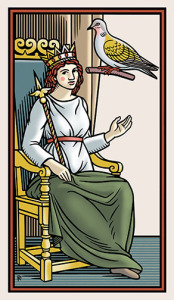The Marziano Tarot
Author: Robert M. Place
Artist: Robert M. Place (recreation of images by Michelino da Besozzo)
Hermes Publications
2016
ISBN #978-0-9915299-2-6

The Marziano Tarot is a recreation of the oldest known Tarot deck, conceived by Marziano da Tortona and first created by Michelino da Besozzo in Milan between 1412 and 1425. The deck consists of four suits comprised of Aces through 10’s, two Court Cards (King and Queen), and four trumps (representing classical gods). The deck is accompanied by an 18 page LWB.
The LWB starts out with a short history of Tarot, and how it was originally used as a trick taking game. Place puts the development of Tarot in Italy over the 15th century as the precursor for the French Marseilles style Tarot.
In the Marziano Tarot, each of the suits is represented by a bird:
Eagles, representing the life goal virtue, and assigned the gods Jove, Apollo, Mercury, and Hercules.
Phoenixes, representing the desire for riches, were assigned the gods Juno, Neptune, Mars, and Acolus.
Turtledoves, representing the goal of chastity, were assigned the goddesses Pallas, Diana, Vesta, and Daphne.
Doves, representing the desire for sensuality, were assigned the gods/goddesses Venus, Bacchus, Ceres, and Cupid.
It was quite interesting to me that Place states that there are no existing cards from this deck. He redesigned this deck as if it had become a standard deck that was later reproduced in woodcuts and hand colored. The images on the cards are based on Marziano’s descriptions as translated by Ross Gregory Caldwell, and on the woodcuts found in the 15th century Hypnerotomahia Poliphili, early printed cards, as well as other Renaissance sources.
The cards are presented in text only, with suggested divinatory meanings. The statements in quotations assigned to each god are taken from Marziano’s descriptions, as translated by Ross Gregory Caldwell.
The final page of the booklet describes how Place sees the cards being read. In their simplest form, he sees the cards as a series of pictures that invite the reader to make up a story. He sees this as an exploration of the unconscious, searching for gems of insight.

The cards are 2 ¾” by 4 ¾”, of sturdy card stock. The backs have a white background, covered in black stars. The central figure is a large bird that appears to have a snake in its mouth. It is not reversible.
The card faces on the pips and court cards show a white border, followed by a black border, surrounding a central image. The trumps show the same borders, with the name of the god/goddess centered at the top of the card, with the card number in Roman numerals under the title, on the left hand side of the card. The card titles are in Italian.

Queen of Turtledoves
A virtuous woman who is true to her word.

Bacco
Bacco (Bacchus) – The embodiment of the grapevine, he represents drunkenness, but also ecstasy, and initiation into the mysteries.

Pallas
Pallas – The embodiment of wisdom, she represents intelligence, debate, and philosophy.

Ace of Eagles
Ace of Eagles – Actions that initiate justice and virtue, a good cause, doing things for the right reason.

Giove
Giove (Jupiter) – The embodiment of justice and just punishment, he represents authority, law, virtue, religion, and truth.

Ace of Doves
Ace of Doves – Beauty for beauty’s sake, leading to spiritual transformation.
This is not a traditional deck, therefore it is not a deck for teaching. It is a unique recreation, and a definite collector’s item. Once the learning curve with only two Court Cards, and the 16 trumps represented by gods/goddesses is accomplished, the deck reads well.
© September 2016 Bonnie Cehovet
Reproduction prohibited without written permission of the author.